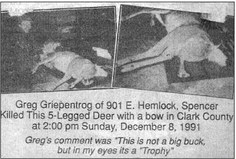PAGING THROUGH H


ABBOTSFORD T RIBUNE PUBLISHED IN ABBOTSFORD THURSDAY, OCTOBER 18, 1951
THE TRIBUNE-P HONOGRAPH PUBLISHED IN ABBOTSFORD WEDNESDAY, OCT. 21, 1981
Rat poison available in Abbotsford Friday Abby City Hall rated by energy auditors When the harvest is over and the weather grows cooler — that’s when rats and mice being their stealthy invasion of farm and city buildings. There, all winter long, the expect to receive free food and shelter.
Abbotsford this year is waging a war on rats and mice, and the village dump and other places where rats congregate will be treated with poison to reduce the population of these rodents.
Local people are warned to keep their pets at home to avoid having them contact the poison used.
Village Marshal Louis Mauritz will be at the village hall Friday afternoon to dispense rat poison to anyone who may want to us it on his own premises, to help in this effort to reduce the number of rats and mice which will be moving indoors for the cold winter months.
Maynard Kaufman in Navy I.C.F.A. Maynard Kauffman, son of Mr. and Mrs. Kauffman, Milwaukee, formerly of Abbotsford, has been assigned to the U.S.S. Gilmore A.S. 16, based at Norfolk, Va. and will go to Key West with the ship.
He enlisted on Jan. 20, though the Milwaukee Naval Recruiting office and was taken March 23. After nine weeks of basic training at Great Lakes, Ill., he attended Interior Communications Class A Service School at Great Lakes and was graduated Oct. 5, with the third highest average of his class.
His work includes telephone work, public address systems, gyro compass, movie and similar specialized work.
The City of Abbotsford could save several thousand dollars a year on energy costs at City Hall, according to an energy audit recently completed by Owen Ayres and Associates.
To save that money, however, the city would have to institute a series of renovations that would initially cost over $25,000, and payback periods for the improvements ranged from under a year to over 16 months.
The city council will soon discuss just how much money it will be willing to pay for improvements in the building, which was constructed in 1958.
The building is heated by five separate oil-fired furnaces — one for the shop, one for the fire station, two of the office-meeting room area and one for the library. The cost of installation of a new heating system would be prohibitive, so the Owen-Ayres report concentrated on energy conservation measures could be accomplished with the present heating system.
The report by the consultant noted several areas in which heat-saving steps could be take. Among the simplest were reducing the outside air intake and the toilet exhaust outlet, and caulking and weatherstripping around doors and windows where feasible. Those measures would cost about $450, and the money would be recovered in a year at most through fuel savings, the report stated.
The step which, according to the report, makes the most economic sense is weatherstripping the six overhead doors in the shop area, at an estimated cost of $3,000.
